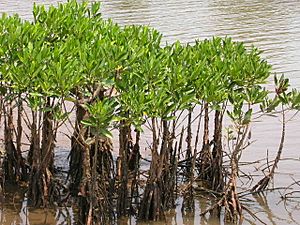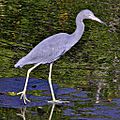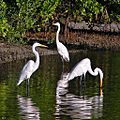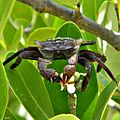Mangrove swamp facts for kids

A mangrove swamp is a special kind of forest or bushy area that grows in salty water. It's made up of unique mangrove trees and shrubs. These amazing plants can live in places where the ocean meets the land, like along coasts. Here, fine mud and sand collect in calm areas, away from strong waves.
Mangroves can handle different levels of saltiness. They can grow in slightly salty water (called brackish water), in regular seawater (which is about 3 to 4% salt), or even in water that's become extra salty from evaporation, sometimes twice as salty as the ocean!
Home for Birds
Mangrove swamps are like safe havens for thousands of water birds. Many different kinds of birds live and find food here. Some famous bird sanctuaries found in mangrove areas include:
- Pulicat Lake Bird Sanctuary
- Mangalavanam Bird Sanctuary
- Salim Ali Bird Sanctuary
- Pichavaram
- Coringa Wildlife Sanctuary
- Sundarbans National Park
Natural Coastal Protection
Mangrove swamps are super important for protecting coastal areas. They help stop the land from washing away (erosion). They also offer protection during big storms, like hurricanes, and even from tsunamis.
The huge root systems of mangrove trees are excellent at slowing down strong waves. They also slow down the incoming tide, which helps mud and sand settle. This way, mangroves actually help build up the land around them!
Because mangrove ecosystems are so unique and offer great protection, many groups work to conserve them. This often includes national plans to protect biodiversity.
While mangroves are very helpful, their protective power is sometimes misunderstood. In places where mangroves grow, the waves are usually not very strong to begin with. So, their effect on everyday erosion might only be seen over a long time. Their best protection comes during big events like storm surges and tsunamis. Sometimes, erosion still happens on the outer edges of river bends that flow through mangroves. But new mangroves often grow on the inner edges where new land is forming.
Images for kids
-
Mangrove ecosystem in the coastal intertidal zone Seagrass and oyster beds can inhabit the shallow subtidal zone -
Diversity of mangroves is greatest in Southeast Asia Distribution of delta, estuary, lagoon and open coast mangrove types in (i) South Asia, (ii) Southeast Asia and (iii) East Asia Bar charts show percentage change in area between 1996 and 2016 -
Sundarbans, world's largest mangrove forest -
The scorpion mud lobster is found in some mangrove swamps. It lives in burrows up to 2 m (6.6 ft) deep, and is active at night. Its burrowing is important for the recycling of nutrients, bringing organic matter up from deep sediments. -
Fate of mangrove primary production A.) Fate of mangrove primary production and importance of each component, as a percentage of net mangrove primary productivity. B.) Isotopic profile of sediments across the transition from mangrove to intertidal mudflats and seagrass beds, illustrating the retention of mangrove productivity within the forest. -
Mangrove roots act as a net, retaining waste. Mayotte at low tide
-
Mangrove kingfishers are found particularly in mangrove zones
-
Brown pelicans fish and nest in mangrove forests
-
Little blue heron. The water is reflecting green mangrove trees.
-
Three great egrets fishing along a mangrove shore
-
Mangrove snapper swimming among mangrove roots
-
Old World silversides schooling among mangrove roots
-
Barracuda lurks among mangrove root
-
Yellow seahorses breed and give birth in Asia’s flooded mangrove forests. Tangled roots and submerged branches offer shadowy shelter to pregnant dads and their offspring
-
Mudskippers can be found in mangrove swamps
See also
 In Spanish: Manglar para niños
In Spanish: Manglar para niños






























